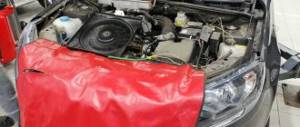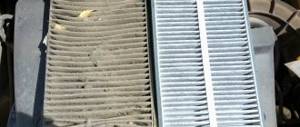16 valve engines
Sixteen valve engines on the Grant were installed under numbers 126 and 127. Initially, the Grants were equipped with a 126 engine, this engine was installed from 2011 to 2020, later replacing the 126, the 127 engine came, which was installed on the Priora 2 and Lada Vesta.
Engine VAZ 21126
This engine was built on the basis of a 124 engine, which is still famous for its reliability. The 126 engine uses automatic tensioning of the timing belt, which avoids the attraction of the belt, which can lead to its breakage. The 16-valve engine uses hydraulic compensators, which allows the engine to adjust the valve clearance under the influence of oil pressure. Also paired with a 16-valve engine in the LUX configuration, an automatic transmission is installed. A significant disadvantage of the 126 engine is the bending of the valves when the timing belt breaks.
Technical characteristics of engine 21126:
| Fuel supply | Injector |
| Number of cylinders | 4 |
| Number of valves | 16 |
| Compression ratio | 11 |
| Power (hp) | 98 |
| Engine capacity (cc. cm) | 1596 |
| Required fuel | Not lower than AI 95 |
| Torque (N*m) | 145 |
Engine VAZ 21127
The VAZ 127 engine is the flagship of the Volzhsky plant. It is this engine that is currently installed on VAZ cars; thanks to the modified DOHC valve timing, it was possible to significantly increase the power of the power unit, which has a very positive effect on the driving characteristics of the car.
Technical characteristics of VAZ 21127:
| Fuel supply | Injector |
| Number of cylinders | 4 |
| Number of valves | 16 |
| Compression ratio | 11 |
| Power (hp) | 106 |
| Engine capacity (cc. cm) | 1596 |
| Required fuel | Not lower than AI 95 |
| Torque (N*m) | 148 |
Engine innovations 21116
The new engine of the VAZ 21116 has become lighter, more torquey and more powerful compared to its predecessor. developed an updated connecting rod and piston group (SHPG). A completely new piston was used, adapted for 2 valves, the connecting rod was taken from the 21126 engine. The height of the upper compression ring is 1.2 mm, the lower one is 1.5 mm, and the oil scraper ring is 2 mm.
Factory tuning ensured a reduction in the weight of the ShPG. Thanks to the modified structure of the piston, connecting rod with liners, piston pin and rings, it was possible to reduce the overall weight of the ShPG. The connecting rod weighs 410 g instead of the previous 707. The piston weight has decreased from 350 g to 243. The pin now weighs 70 g, previously its weight was 113 g. The overall weight reduction is 39% (723 g / 1170 g). A lightweight ShPG allows you to increase power, reduce vibration and noise, and also significantly reduce specific fuel consumption.
An additional oil nozzle is installed in each cylinder to ensure that the pistons are cooled more intensively. The cylinder walls are processed using an improved technology - plate honing (flat-top honing). The same crankshaft model is used with a crank radius of 37.8 mm. The tension of the new Gates timing belt is automatically maintained.
A completely new cylinder head has been developed. It contains additional positions for attaching the new timing belt tensioning mechanism. Differences are observed both in the collector pipe area itself and in the fastening of the receiving pipe. There are no valve lifters.
A metal two-layer cylinder head gasket with a thickness of 0.43 mm is used. The new H intake module features longer ducts to increase torque. Added electromechanical throttle module.
The structure of the catalytic converter (catalytic converter), which is responsible for reducing the harmfulness of exhaust gases, has been changed, and the exhaust manifold channels have been lengthened. Thanks to this, the gas flows were diluted, thereby the motor carries less and the resistance decreases.
8 valve engines
Unlike 16 valves, a single-shaft gas distribution system is used here. There are two valves for each cylinder: intake and exhaust. Such engines are reliable and do not bend valves when the timing belt breaks, but are significantly inferior in the dynamic performance of the vehicle, as well as in the noise level of the internal combustion engine.
Engine VAZ 11183
This engine was installed not only on Grants, but also on the last 2114 years of production. The engine is quite noisy and requires frequent valve adjustment due to the lack of hydraulic compensators. 183 the engine does not bend the valve when the timing belt breaks. This is the only engine installed on the Grant that is not afraid of timing belt breakage.
Technical characteristics of VAZ 11183:
| Fuel supply | Injector |
| Number of cylinders | 4 |
| Number of valves | 8 |
| Compression ratio | 10 |
| Power (hp) | 82 |
| Engine capacity (cc. cm) | 1596 |
| Required fuel | Not lower than AI 95 |
| Torque (N*m) | 120 |
Engine VAZ 11186
This engine is installed in the last years of Granta production. It significantly reduced the noise characteristics and increased the compression ratio, which led to the meeting of the valves with the pistons when the timing belt breaks. Increasing the compression ratio made it possible to achieve more power from the internal combustion engine, which was beneficial for the dynamic characteristics.
Technical characteristics of VAZ 11186:
| Fuel supply | Injector |
| Number of cylinders | 4 |
| Number of valves | 8 |
| Compression ratio | 10,5 |
| Power (hp) | 90 |
| Engine capacity (cc. cm) | 1596 |
| Required fuel | Not lower than AI 95 |
| Torque (N*m) | 143 |
Kalina NFR engine
Kalina with the NFR prefix is equipped with the most powerful engine installed in the Lada, VAZ 21126-81. The NFR has the same engine as the sport modification, but more powerful. Sports camshafts, intake and exhaust manifolds gave the engine more agility and playfulness.
ICE characteristics
Advantages and disadvantages
Pros:
- High speed;
- High torque;
- Powerful engine;
Minuses:
- Bend valves when the belt breaks;
- Small resource;
- High fuel consumption;
Advantages and disadvantages
VAZ 21116 is an easy-to-maintain and at the same time reliable engine. Once every 15,000 kilometers it is necessary to change the engine oil. The timing belt should be inspected every 25,000 kilometers, and replaced after 200,000 km.
The advantages include the low cost of the cylinder head and reduced noise level. And major repairs can be carried out by a car owner who has experience in disassembling and assembling engines. This is possible because the engine components are interchangeable. Easy dismantling of mounted elements makes it unnecessary to disassemble the engine part of the vehicle.
Similar article M103 Mercedes engine
The advantages of the VAZ engine include:
- ease of repair;
- good traction at low speeds;
- there is no need to tighten the timing belt, since the tensioner is in effect. If you try to tension the belt and tighten it yourself, the roller bearings and water pump will fail;
- The timing drive is protected by a plastic impact-resistant casing;
- economical fuel consumption;
- reliability and durability.
However, there are also disadvantages to this unit. Experienced car owners note:
- the need to regulate valve clearances, since there are no hydraulic compensators;
- frequent malfunctions during operation of even a new VAZ engine;
- low environmental friendliness, which does not meet European standards and does not reach modern Euro 4;
- purchase of expensive foreign components.
The unit often has problems with some sensors at idle. This is a childhood disease that was abandoned by engineers from the moment the engine was released. Therefore, it cannot be corrected and you have to accept it.
Design Features
Important changes that occurred in the 21116 engine include the replacement of the connecting rod and piston group. It was ordered from Federal Mogul under catalog number 1004010. Now the connecting rod and piston group has become lightweight. Thanks to this replacement, the engine power increased, vibration and extraneous sounds from the engine in the cabin decreased. Reduced fuel consumption.
Now the connecting rod and piston group is equipped with the following parts:
- oil rings of sizes 1.2, 1.5, 2 mm;
- connecting rod parts designed for VAZ 21116.
The VAZ engine cooling system was changed. The number of nozzles for cooling the pistons with lubricant has been increased. The cylinder diameter was set at 82 mm and the height at 197.1 mm. The cylinders are plate-honed.
Similar article The principle of operation of a hybrid car engine
The gas distribution mechanism was made more reliable and powerful. Instead of a chain, they installed a belt, since when it broke, the valves constantly bent. The lifespan of a timing belt is 200 thousand kilometers.
Attention! The belt was purchased from. It can be found under catalog number 21116-1006040-00. Timing belt width – 22 mm.
Due to changes in the gas distribution mechanism, it was necessary to install a spacer washer under VAZ catalog number 21116-1005317 on the crankshaft. Installing this part allowed the pulleys not to change their position during operation.
Additionally, the following components were introduced:
- automatic tensioner for toothed belt;
- toothed pulley for crankshaft;
- toothed pulley for camshaft.
The weight of the VAZ engine is 112 kg, despite the fact that the cylinder block is cast from cast iron. It is characterized by increased resistance to overheating.
Since the eight-valve engines of the VAZ 21114, this engine is distinguished by smooth operation and automatic control, because an injection system is used. Economy is also excellent. For example. On the highway, fuel consumption is 7.5 liters per 100 km.
Faults and repairs of internal combustion engines 21116
Experienced mechanics often refer to the following faults:
- floating speed of the VAZ engine. In this case, the electronic throttle valve E-gas suffers. It is usually replaced with a new one;
- knocking noises in a VAZ engine appear when the valves do not operate synchronously. This happens when the VAZ engine valves are rarely adjusted. If the car owner has recently adjusted the valves, and knocking still continues to come from the engine, then experienced mechanics recommend checking the main or connecting rod bearings;
- engine tripping occurs due to the fact that the four-terminal ignition coil has failed. Sometimes the engine may stall due to burnt valves. True, recent breakdowns do not happen often;
- overheating occurs due to clogged cooling system pipes. Carbon deposits accumulate inside the pipes and radiator and prevent the oil from circulating normally. Breakdowns also occur with the thermostat, and the fan fails. Because of this, the motor overheats.
Similar article Characteristics and problems of the 646 Mercedes engine
If the water pump breaks, it is usually the timing belt that is stuck. In this case, the engine valves bend. Therefore, it is important to monitor the operation of the pump. Its timely replacement will save the VAZ car owner from major engine repairs.
During annual preventive maintenance, the following components are replaced:
- spark plugs are changed after 2 years or twenty thousand kilometers;
- oxygen sensor - after one hundred thousand kilometers;
- air and fuel filters are changed simultaneously after 40 thousand km;
- The battery is changed after two years if it has exhausted its lifespan.
After 40 thousand kilometers, they check the gas tank cap, fuel wire, fittings and hoses for cooling and heating the engine, and exhaust manifold.
Experienced car owners and mechanics can increase the power of a VAZ engine to 50 horses. But this will have a bad effect on the resource of the engine. Motor components will be subject to rapid wear. Therefore, for those who want to tune the engine to increase the power of the VAZ, it is recommended to consult with experienced mechanics. Perhaps they will advise modifying the exhaust manifold or replacing the standard pump with a pump from Luzar.
They can install a turbine. In this case, the cost of tuning will increase several times.











